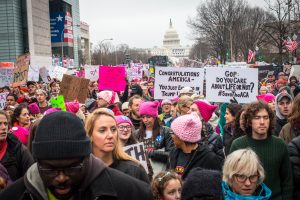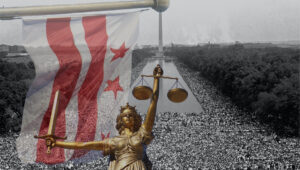According to Troubles I’ve Seen, Jervis Anderson’s biography of Bayard Rustin, whenever Rustin, chief organizer of the March on Washington, was asked to organize similar events, he would wisely reply, “If you bring off a good thing, you shouldn’t try to repeat it.” And a good thing it was: as Anderson’s book recounts, on a sweltering August day in 1963, the centennial year of the Emancipation Proclamation, 250,000 Americans, three quarters of them people of color, peacefully marched down the National Mall to bring attention to their enduring struggle for freedom. The march precipitated the passage of the Civil Rights Act of 1964 and the Voting Rights Act of 1965; thus, in effect as well as in execution, it was a very good thing indeed. Rustin obeyed his maxim, transitioning after a period of well-earned celebrity to lower-profile roles in the anti-war and LGBT movements. But that didn’t stop others from trying to recapture the magic of that day.
Indeed, the March on Washington for Jobs and Freedom has since become—in varying contexts—a glorious memory, a beloved cliché, and a powerful model. The method of mass protest in the streets of our nation’s capital, though surely not invented by Rustin and his compatriots, has since become the tactic of choice of any self-respecting activist group. Vietnam protests overran the Mall during the late ’60s and early ’70s. Anti-abortion activists have staged annual marches since 1976.
And, as anyone who has lived in D.C. during the presidencies of George W. Bush and Donald Trump can tell you, marches on the capital are becoming more frequent. One need only consider the huge turnout to the now annual Women’s March, or the record-setting numbers of last year’s March for Our Lives, to see that D.C. protests remain a fixture of national political life.
Despite my best (and most misguided) efforts, this is not a political column. My primary concern is Washington, D.C., and the ways in which an evolving culture of protest has influenced—and been influenced by—a changing Washington. The symbolic and practical reasons for protesting in D.C. are obvious; less often examined are the marks that marches and rallies leave on the city and its people.
Few know, for example, as Anderson points out in his biography of Rustin, that the white residents of Washington were terrified at the prospect of 250,000 black people descending on the capital for the 1963 march. According to Anderson, thousands of white people fled D.C. for the Virginia suburbs, anticipating riots that never began and violence that didn’t break out. If anything, this act of fear made organization of the march easier; it also foreshadowed the white reaction to another significant, albeit less peaceful, airing of grievances.
Riots broke out nationwide following the assassination of Martin Luther King, Jr. in 1968. D.C. was one of the country’s most affected cities, and the riots, concentrated in Shaw, Columbia Heights, and the U Street Corridor, sent reverberations that continue to be felt today. Dr. King would certainly object to my inclusion of the ’68 riots in this list of demonstrations in the city of Washington, on the grounds that a violent demonstration is no demonstration at all. I would counter with the contention that each protest is the product of its particular historical moment—if 1963 was a moment of peaceable hope, 1968 was violence’s time. And so, as Richard Nixon began the process of scaling up aggression against two sovereign nations in Southeast Asia, some of D.C.’s black residents turned their frustration into aggression against a city and nation that had promised so much and delivered so little.
The spectacle, whole neighborhoods burning mere blocks from Capitol Hill, was powerful—perhaps just as powerful as the image of 250,000 people marching on the Mall. Exasperation, not hope, was the word of the day. Afterwards, entire blocks lay in rubble. Many whites fled the city, this time for good. Affected neighborhoods remained underfunded and forgotten for decades.
Decades later in 1995, the city hosted Louis Farrakhan’s Million Man March. It came in the wake of L.A.’s Rodney King riots in which thousands took to the streets of L.A. County to protest the severe beating of an unarmed black man. Its name makes obvious the aim of all marches, that is, to create spectacle—to make seen a salient political fact that would have otherwise remained hidden in the woodwork. It is perhaps unsurprising that fierce debates ensued as to whether the event met its titular goal. The National Park Service (NPS) provided the lowest estimate, at just over 400,000; the fallout that ensued over this dubious number is the primary reason that NPS no longer estimates crowd sizes.
Nowadays, march organizers have no trouble drawing crowds of hundreds of thousands to the Capital every year. Social media and other advances in communications technology certainly deserve some of the credit for this development, but the rest must be attributed to our particular historical moment—a shift in thinking about what political engagement is and what it should be. We are reaching once again, as Rustin did in 1963, toward a more democratic civic life, in which the average American can (and to some extent is expected to) take a stand outside of the voting booth. But what does this new politics of spectacle, this 21st-century manifestation of a decades-old tactic, mean for the District? What does it mean for protest more generally?
First of all, it means more work for the city’s tourism board. Hard data is hard to come by, but it is not inflationary to estimate that hundreds of thousands of out-of-towners have come to D.C. for protests during the presidency of Donald Trump alone. The phenomenon of “protest tourism” has become so significant that Destination D.C. has even begun marketing marches, providing tourists with such essential data as where to find a bathroom on the National Mall. Protest is becoming a business, as most popular things eventually do.
But here we encounter the paradox of plenty: when protests (and social media posts proving one’s attendance at said protest) become more frequent, it becomes harder to know which are worth paying attention to. It’s a rare week that goes by in Washington without a protest of some significance, and now that the Women’s March as well as the March for Life are annual, the National Mall is starting to look pretty crowded. Protests in the past worked not merely because they had spectacle, but because they were spectacular, out of the ordinary, special in some way. The March on Washington was special because it was first; the ‘68 riots because they were not peaceful; the Million Man March because it was so big. The D.C. superlatives are dwindling, and the power of each march on the capital diluting in equal measure. It is time to reexamine whether the spectacle might have, somewhere along the line, eclipsed the substance.
Perhaps it is time as well to heed Rustin’s words, and stop trying to bring a good thing off again. Or maybe we have only to realize that we have been bringing off good things—elsewhere. The Women’s March and March for Our Lives were special, very special indeed, because they didn’t just happen in D.C. By some genius of grassroots organization, they happened everywhere, almost simultaneously and in huge numbers. So that even if legislators on Capitol Hill weren’t listening, voters and legislators in Sacramento and Wichita and Dallas and Albany were. I believe that the democratization of protest—geographically as well as philosophically—is what ultimately led to Democratic Party victories in the 2018 midterms. Mobilizing voter turnout, promoting the candidacies of women and people of color, centering the issues that matter most to people—these are the extraordinary impacts of widespread local protest. D.C. marches will surely continue (there is, after all, profit to be made and pictures to be posted), but I believe they will decrease in salience as attention begins to turn toward grassroots organization and local protest.
I and many others will continue to demonstrate in D.C. because, in the final analysis, I believe it does more good than harm. But I will focus my time and energy on causes local to this community—on advancing, for instance, the cause of equitable development that combats displacement. I advocate protesting, wherever you are, if only for the psychological benefits of standing in the midst of a living democracy. But I am wary of the thoughtless replication of the concentrated mass-mobilization that worked 50 years ago, in a different historical moment. Rather than traveling year after year to the capital to air your grievances, consider capitalizing on the special characteristics of the age of social media by protesting in your hometown, where local politicians are more likely to hear you. Organization has never been easier. Gone are the days when an organizer like Rustin was needed to amplify the voice of America. We can, increasingly, do it ourselves, wherever we are. Local organization is the special privilege and responsibility of this historical moment. We must not be beholden to the tactics of the past if we want success in the present.





